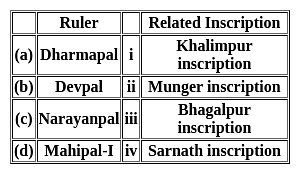UGC NET Paper 2 History Mock Test - 10 - UGC NET MCQ
30 Questions MCQ Test - UGC NET Paper 2 History Mock Test - 10
Consider the following statements.
1. The Mughal emperors patronised the Dhrupad form of music.
2. Mughal miniature paintings give evidence that music was employed in Mughal courts.
Which of the above statements is/are correct?
Consider the following statements about the Indian Freedom Struggle :
1. With the help of Hitler, the ‘Freedom Army’ (Mukti Sena) was formed which consisted of all the prisoners of war of Indian origin captured by Germany, Italy and Japan.
2. Subhash Chandra Bose came to be called ‘Netaji’ by the people of Germany.
Which of the above statement(s) is/are correct?
| 1 Crore+ students have signed up on EduRev. Have you? Download the App |
Which of the following statements is/are true?
- On 12 August 1764, the Mughal emperor appointed the East India Company as the Diwan of Bengal.
- In 1770, a terrible famine killed ten million people in Bengal wiping out about one-third of the population.
- Permanent Settlement was introduced in 1793 recognising the rajas and taluqdars as zamindars
Which of the following are the characteristics of the Christian view of history?
A. It is universal in its approach.
B. It believes in divine providence.
C. It is apocalyptic.
D. It believes in the existence of two cities.
Consider the following statements.
1. The term Saracenic has been derived from Roman people that lived in Arabia.
2. It was a synthesis of Victorian Gothic architecture with Mughal architecture.
3. The Pietra dura technique developed in French Gothic architecture.
Which of the above statements is/are correct?
Match the following list:

Choose the correct combination given below:
Asoka is throughout referred to as ‘Devanampiya’ and ‘Piyadasi’ in his edicts except a few. Which are such exceptions?
(i) Maski
(ii) Gujarra
(iii) Nittur
(iv) Udegolam
Select the correct answer with the help of the codes given below:
Which is that source which gives a lie to the tradition of a fratricidal war of Asoka?
In which of his following inscriptions did Asoka declare that all people were his children?
Given below are two statements, one labelled as Assertion (A) and the other labelled as Reason (R).
Assertion (A) : Despite its name, the Hindu Code Bill was to apply to Sikhs, Buddhists, and Jains as well as Hindu castes and sects.
Reason (R) : After independence, among those favouring a common civil code were the Prime Minister Jawaharlal Nehru and the law minister, Dr. B.R. Ambedkar.
In the context of these statements, which of the following is correct ?
Consider the pair of terms associated with the following facts (Administrative Measures of Akbar – Years):
1. Appointment of Amils / Karoris - 1574
2. Bringing the territory of Hindustan (from Lahore to Allahabad) under Khalisa - 1576
3. Grouping of land under assessment circles called Dastur - 1580
Which of the above pairs is/are not correctly matched?
Consider the following statements.
1) The East India Company secured royal dastaks under the royal farman by the Mughal Emperor in 1700.
2) The East India Company servants were permitted to trade and were not required to pay taxes under this farman.
Choose the correct statements.
Consider the following statements.
I. Mathura school of Buddhist art was developed by the Kushan dynasty.
II. Gandhara school of Art was developed by Sunga dynasty.
III. Amravati School was developed by the Satvahana dynasty.
Choose the incorrect statement.
Consider the following statements.
1) Charter Act of 1813 incorporated the principle of encouraging learned Indians and promoting the knowledge of modern sciences.
2) English Education Act 1835 decided to devote the teaching of Western Sciences and literature through the medium of English and as well as through the Indian languages.
3) The Wood’s Dispatch of 1854 repudiated the ‘downward filtration’ theory.
Choose the correct statements.
Consider the following statements:
Assertion(A):- The infant mortality rate in the chalcolithic age was quite low.
Reason(R):- They were food producing economy.
According to Historical Materialism, the primary driver of social change is
Consider the following Pairs:
 How many pair/s given above is are correctly matched?
How many pair/s given above is are correctly matched?
Which of the following statements is correct?
I. Tipu Sultan is also known as the Tiger of Mysore.
II. Tipu Sultan ruled over Mysore from 1782 to 1799.
Which of the following rulers got the title of ‘Jagatguru’ by his Muslim subjects because of his secularist policies?
Below given are two statements, one is labelled as Assertion (A) and the other as Reason (R)
Assertion(A): Big buildings were the distinguishing feature of both Harappa and Mohen-jo-daro.
Reason(R): Their monuments symbolized the ability of the ruling class to mobilize labour and collect tax.
Select the correct answer using the codes given below :
Mahabalipuram is known for its world heritage site complex of the group of monuments. Consider these statements about it:
- These are the gems constructed at the times of Pallavas.
- Most monuments at Mahabalipuram are rock cut and monolithic.
- Each of the Panch Rathas is carved out of one single large piece of stone in similar style.
Which of the statements given above are correct?
Which one of the following is considered the earliest example of a Panchayatana composition in Indian temple architecture?
Which of the following is not a composition of Saint Tulsidas?
During British Era, the Duke Memorandum became the basis of which among the following?
Consider the following statements about Kranti Diwas:
- The day is observed to remember the historic 'Quit India Movement' initiated by Mahatma Gandhi.
- Freedom fighters who are still alive are honoured by their respective states and concerned authorities at Rashtrapati Bhavan on this day.
Battle of Mandsaur was fought between which parties?
Who of the following is the author of the book ” The first war of Indian Independence”



















